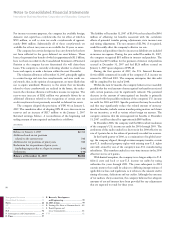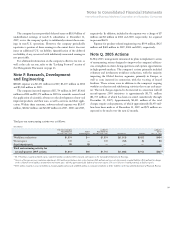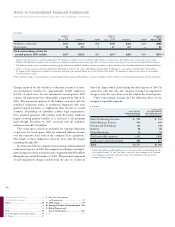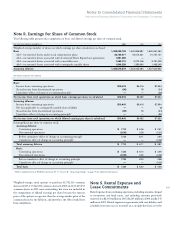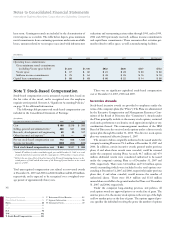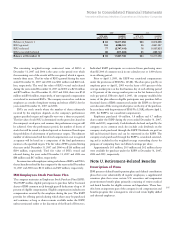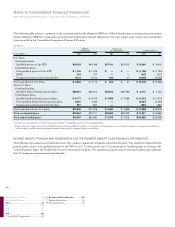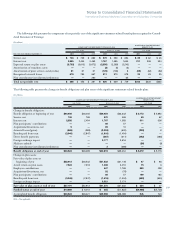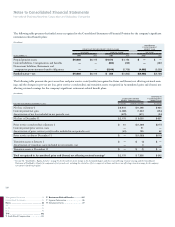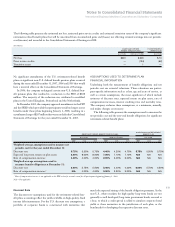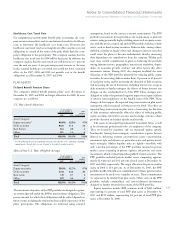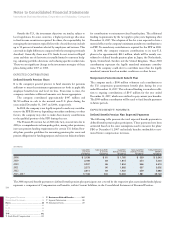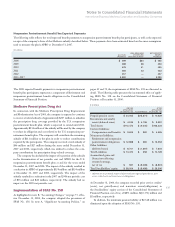IBM 2007 Annual Report Download - page 108
Download and view the complete annual report
Please find page 108 of the 2007 IBM annual report below. You can navigate through the pages in the report by either clicking on the pages listed below, or by using the keyword search tool below to find specific information within the annual report.
106
Notes to Consolidated Financial Statements
International Business Machines Corporation and Subsidiary Companies
U.S. PLANS
Defined Benefit Pension Plans
IBM Personal Pension Plan
IBM provides U.S. regular, full-time and part-time employees hired
prior to January 1, 2005 with noncontributory defined benefit pension
benefits via the IBM Personal Pension Plan (PPP). The PPP consists
of a tax-qualified (qualified) plan and a non-tax qualified (non-quali-
fied) plan. The qualified plan is funded by company contributions
to an irrevocable trust fund, which is held for the sole benefit of par-
ticipants and beneficiaries. The non-qualified plan, which is unfunded,
provides benefits in excess of IRS limitations for qualified plans.
Benefits provided to the PPP participants are calculated using
benefit formulas that vary based on the participant. Pension benefits
are calculated using one of two methods based upon specified crite-
ria used to determine each participant’s eligibility. The first method
uses a five-year, final pay formula that determines benefits based on
salary, years of service, mortality and other participant-specific fac-
tors. The second method is a cash balance formula that calculates
benefits using a percentage of employees’ annual salary, as well as an
interest crediting rate.
Benefit accruals under the PPP ceased effective January 1, 2008
for all participants.
U.S. Supplemental Executive Retention Plan
The company also sponsors a non-qualified U.S. Supplemental
Executive Reten tion Plan (SERP). The SERP, which is unfunded,
provides benefits to eligible U.S. executives based on average earn-
ings, years of service and age at termination of employment. Effective
July 1, 1999, the company replaced the then-effective SERP with the
current SERP. Some participants in the previous SERP will still be
eligible for benefits under that prior plan if those benefits are greater
than the benefits provided under the current plan.
Benefit accruals under the SERP ceased effective January 1, 2008
for all participants.
Defined Contribution Plans
IBM Savings Plan
U.S. regular, full-time and part-time employees are eligible to
participate in the IBM Savings Plan, which is a qualified defined
contribution plan under section 401(k) of the Internal Revenue
Code. For participants hired prior to January 1, 2005, the company
matches 50 percent of their contributions up to the first 6 percent of
eligible compensation. For participants hired or rehired on or after
January 1, 2005, who have completed one year of service, the company
matches 100 percent of their contributions up to the first 6 percent
of eligible compensation. These participants participate in the 401(k)
Pension Program offered through the IBM Savings Plan. The com-
pany’s matching contributions vest immediately and participants are
always fully vested in their own contributions. All contributions,
including the company match, are made in cash, in accordance
with the participants’ investment elections. There are no minimum
amounts that must be invested in company stock, and there are no
restrictions on transferring amounts out of the company stock to
another investment choice.
Effective January 1, 2008, the IBM Savings Plan, including the
401(k) Pension Program, became the IBM 401(k) Plus Plan. Under the
IBM 401(k) Plus Plan, eligible employees will receive a dollar-for-
dollar match of up to 6 percent of eligible compensation for employ-
ees hired prior to January 1, 2005 and up to 5 percent of eligible
compensation for employees hired on or after January 1, 2005. In
addition, under the IBM 401(k) Plus Plan, eligible employees will
receive automatic contributions from the company equal to 1, 2 or 4
percent of employees’ eligible compensation based on their eligibility
to participate in the PPP as of December 31, 2007. If an employee
was hired on or after January 1, 2005, the employee would be eligible
to receive automatic contributions and matching contributions after
the completion of one year of service.
IBM Executive Deferred Compensation Plan
The company also maintains an unfunded, non-qualified, defined
contribution plan, the IBM Executive Deferred Compensation Plan
(EDCP), which allows eligible executives to defer compensation and
to receive company matching contributions under the applicable IBM
Savings Plan formula (depending on the date of hire, as described
earlier), with respect to amounts in excess of IRS limits for qualified
plans. Amounts contributed to the EDCP as a result of deferred com-
pensation, as well as company matching contributions, are recorded
as liabilities. Deferred compensation amounts may be directed by
participants into an account that replicates the return that would
have been received had the amounts been invested in similar IBM
Savings Plan investment options. The company matching contribu-
tions are directed to participant accounts and change in value each
reporting period based on changes in the company’s stock price.
Effective January 1, 2008, the EDCP was replaced with a new
non-qualified deferred compensation plan, the IBM Excess 401(k)
Plus Plan (Excess Plan). All employees whose eligible compensation
is expected to exceed the IRS compensation limit are eligible to par-
ticipate in the Excess Plan. The purpose of the Excess Plan is to
provide benefits that would be provided under the qualified IBM
401(k) Plus Plan if the compensation limits did not apply. The Excess
Plan, like the EDCP, will provide employees with the opportunity to
save for retirement on a tax-deferred basis.
Management Discussion ..................................14
Consolidated Statements ..................................14
Notes ........................................................... 64
A-F ...................................................................64
G-M ..................................................................84
N-S ...................................................................94
T-W ........................................................... 102
T. Stock-Based Compensation ......................102
U. Retirement-Related Benefits .............. 105
V. Segment Information ................................116
W. Subsequent Events ....................................119




